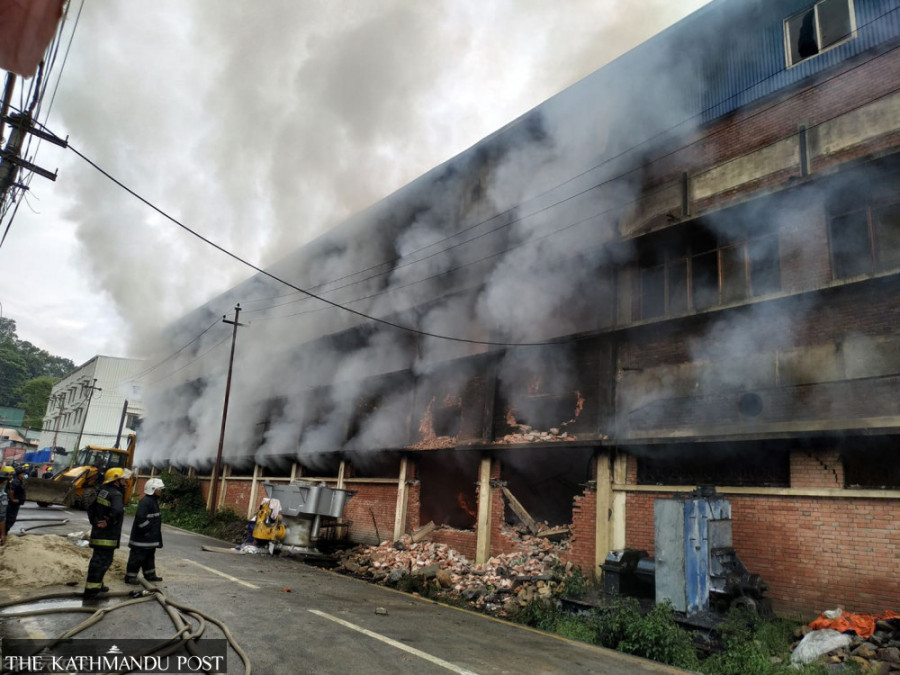National
Poor roads, equipment shortage make firefighting more difficult in rural areas
Between April 8, 2020 and April 7, 2021, a total of 2, 765 fire incidents were recorded across the country by the Ministry of Home Affairs.
Shuvam Dhungana
On Saturday at around 2:20am, a massive fire broke out at Balaju Industrial Estate of Kathmandu destroying property worth millions.
To contain the blaze, more than 800 personnel from Nepal Police, Nepal Army, Armed Police Force and firefighters were mobilised, according to Senior Superintendent Ashok Singh, chief of the Kathmandu Metropolitan Police Range.
“It took over nine fire engines, 40 water tankers, two bulldozers, one crane, one tipper truck, two mini trucks and a helicopter to contain the blaze,” said Singh.
Despite the use of such a huge amount of manpower and equipment, it took more than 10 hours to bring the inferno under control.
The Saturday incident has exposed how ill-prepared cities are when it comes to controlling fire incidents. Fire fighting becomes more difficult if the incident site is located in rural areas where there are neither proper resources nor skilled manpower to contain fire.
According to Senior Superintendent Basanta Bahadur Kunwar, spokesperson for Nepal Police, if any incidents related to fire take place anywhere in the country, they are the first responders.
“Usually we coordinate with local authorities and inform fire trucks and water tankers to deal with such incidents. However, if the site of the incident is in a rural area where such emergency vehicles are not available, it becomes difficult to control the fire,” said Kunwar.
On Friday, in another similar incident a tea factory was gutted at Suryodaya Municipality-7, in Ilam district. The damage was estimated at Rs2.8 million.
The incident occurred when the fire used for drying tea leaves went out of control destroying 600 kilograms of tea and machinery, according to the press release provided by District Police Office Ilam.
According to Chief District Officer of Ilam Dhurba Bahadur Khadka, by the time fire trucks reached the site the damage had already been done.
“We have only three fire trucks in the entire Ilam district and they are deployed whenever there is a fire incident. But on Friday the fire trucks could not reach the site on time due to poor road conditions and when they reached the site everything had been gutted already,” said Khadka.
In most of the fire-related incidents, local police and local people deal with it by using locally available resources like water, mud and tree branches as many of the places are not accessible to fire trucks, he added.
In Nepal, incidents related to wildfire and fire are very common which destroy property worth millions and kill dozens of people every year.
Despite their annual occurrences and increasing losses, successive governments have not paid adequate attention to the management of fire incidents.
According to the data provided by Nepal Disaster Risk Reduction Portal, a total of 14 fire incidents were recorded across the country in the last seven days.
Between April 8, 2020 and April 7, 2021, a total of 2, 765 fire incidents were recorded across the country by the Ministry of Home Affairs.
During the same period, a total of 105 people lost their lives in incidents related to fire and 3,544 families were affected, data show.
But when it comes to resources, Nepal is still far behind.
In Province 1, there are only 20 fire engines, 9 in Province 2, 11 in the Bagmati Province, nine in Gandaki, 10 in Lumbini, five in Karnali, and in the Sudurpaschim Province there are just 9 fire engines.
According to Anil Pokharel, chief executive officer of the National Disaster Risk Reduction and Management Authority, firefighting is a tough job and it becomes even more challenging when the resources are limited like in Nepal’s case.
“If Saturday’s fire incident at Balaju hadn’t occurred in a biscuit factory but in a chemical factory or an oil storage it would have wreaked havoc,” said Pokharel. “Even developed countries like the USA and Australia face difficulties tackling huge blazes, so it is normal that it is even tougher in conditions like ours.”
Pokharel said in rural areas that often see fire incidents, local authorities could build artificial ponds, and could use water pumps to douse fires.
“However, due to untrained manpower and lack of proper knowledge and seriousness such incidents often occur destroying property worth millions,” said Pokharel.




 15.69°C Kathmandu
15.69°C Kathmandu







%20(1).jpg&w=300&height=200)






